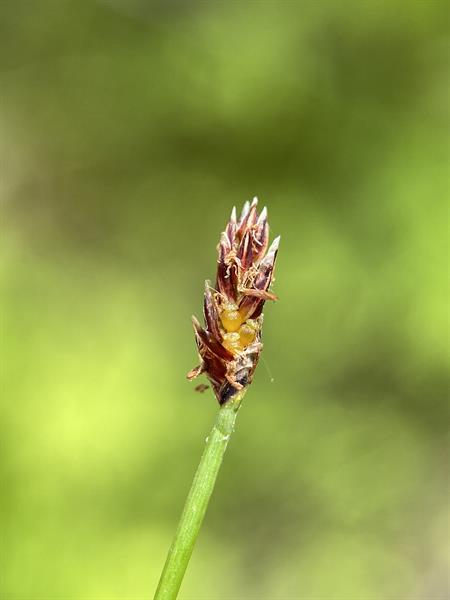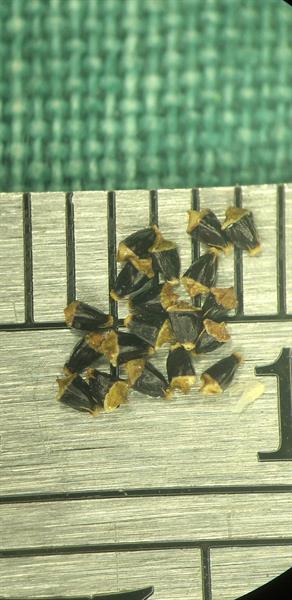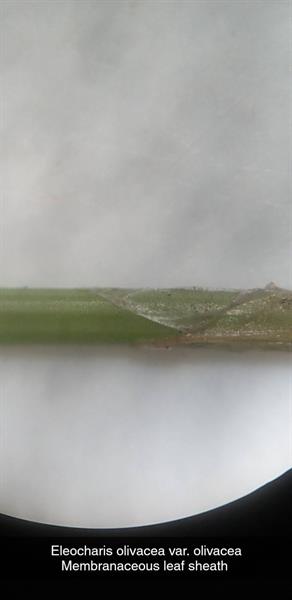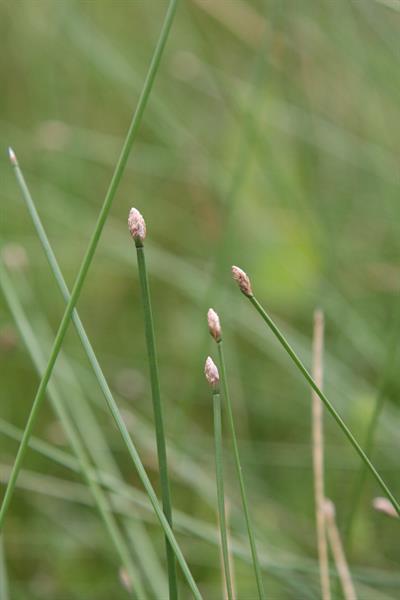
Contributed by Scott G. Ward, Bruce A. Sorrie, and Alan S. Weakley
A genus of about 120-200 species, herbs, cosmopolitan. A molecular study supported the monophyly of subgenus Limnochloa (Roalson & Friar 2000).
subgenus Eleocharis
section Eleocharis
series Eleocharis
subseries Eleocharis: erythropoda, fallax, palustris
subseries Truncatae: bifida, compressa, elliptica, intermedia, montevidensis, tenuis, tricostata, verrucosa
series Albidae: albida
series Melanocarpae: melanocarpa
series Rostellatae: rostellata
series Tenuissimae
subseries Chaetariae: baldwinii, brittonii, microcarpa var. filiculmis, microcarpa var. microcarpa, nigrescens, setifolia, tortilis, tuberculosa, vivipara
section Eleogenus
series Ovatae: engelmannii, obtusa, ovata
series Maculosae
subseries Ocreatae: flavescens, olivacea
subseries Rigidae: atropurpurea, geniculata
section Parvulae: parvula
subgenus Limnochloa
section Limnochloa: cellulosa, elongata, equisetoides, interstincta, quadrangulata, robbinsii
subgenus Scirpidium
section Scirpidium: acicularis, radicans
ID notes:Defining characters for Eleocharis include culms with a single terminal spikelet (sometimes referred to as a spike), or culms bearing proliferous (asexual) spikelets; 2-many scales arranged distichously or spiraled per spikelet, bisexual flowers (each with a subtending scale), styles 2 or 3; achenes biconvex or trigonous, with a persistent style base or tubercle (rarely only containing a beak as in E. confervoides), tubercles confluent (merged) or clearly separate from the achene; achenes with or without a perianth of bristles; culms terete, compressed, trigonous, or 4-5(-10) angled (sometimes obscurely), culms unbranched or whorled, bearing transverse septae or not, these septae either externally evident or only upon sectioning of the culm; and plants either annual or perennial. The culms are bladeless, and instead, leaves are reduced to sheaths; the apex and texture of these sheaths is important, especially when bearing a small tooth. Proliferous spikelets refer to instances in which new "pseudoviviparous" culms arise from asexual spikelets, these then tip-rooting or not. For species with proliferous spikelets, plants can contain a mix of vegetatively-spreading and reproductive culms, being most evident in aquatic habitats that undergo seasonal fluctuations in water levels. Some species, including many in series Tenuissimae, are notorious for vegetative spread and commonly produce proliferous spikelets (E. baldwinii, E. vivipara); others use this strategy more intermittently (E. minima, E. microcarpa); other species (Eleocharis rostellata and Eleocharis melanocarpa) can often have plants with only vegetative or only reproductive culms within areas of the same population, often dependent upon varying water levels throughout a site. Some species, when growing as submersed aquatics, produce only vegetative, flaccid culms, but these do not produce proliferous spikelets (E. robbinsii and E. elongata ). Most species of Eleocharis do not spread via proliferous spikelets (though it is an important and unique feature in the genus), instead producing culms with a single apical spikelet with a few to many achene-bearing scales.
Key advice:Essential characters emphasized in this key concern achene shape, texture and size, of which the achene length may require a micro-ruler in some instances. Achene measurements refer to the achene body only; tubercle measurements are described separately, when utilized. Keying of Eleocharis specimens will not be possible without at least 10-40x magnification. The secondary character in Key E vs. Key F (styles bifid vs. trifid) represents the majority of achenes for each species. Since some achenes (a minority) can have differing style branch numbers within a species, caution must be taken to analyze the majority of the styles present; ultimately deciphering the achene shape is most crucial. When deciding between Key E and Key F, unless achenes are not clearly 2-sided (biconvex), then the species will likely key in Key F, even if its achenes are obscurely 3-sided. Special attention must also be paid to the basal-most scales within a spikelet and whether it is amplexicaulous, i.e. completely encircling the culm, or only encircling 1/2-3/4 of the culm width, as well as if apical leaf sheaths contain a conspicuous tooth (which differs from an acute sheath apex) or not. Again, consult multiple examples within a specimen or population for a majority representation of characters.
Ref: Angelo, Rosen, & Lange (2020); Bridges (1994); Bruhl (2002a) In Flora of North America Editorial Committee (2002b); Brunton, Campbell, & Reznicek (2018); Gibbons & McMullen (2019); Gilly (1941); Goetghebeur In Kubitzki (1998b); Haines (2001); Haines (2003d); Hinchliff & Roalson (2009); Hinchliff et al. (2010); Larson & Catling (1996); Lowe & Carter (2022b); Menapace (1993); Roalson & Friar (2000); Rosen (2006); Rosen & Reid (2015); Rosen, Hatch, & Carter (2007); Rosen, Hatch, & Carter (2008); Smith et al. (2002) In Flora of North America Editorial Committee (2002b); Socorro González-Elizondo & Peterson (1997); Sorrie & LeBlond (2014); Svenson (1957); Ungberg (2022) In Weakley et al. (2022); Ward & Leigh (1975); Yashiro & Endo (2021). Show full citations.
Hover over a shape, letter, icon, or arrow on the map for definition or see the legend. Data for arrows not developed for genera and families which may have species only occurring outside the flora area.
 © Gary P. Fleming | Eleocharis tuberculosa | Original Image ⭷
© Gary P. Fleming | Eleocharis tuberculosa | Original Image ⭷ © Scott Ward | Eleocharis robbinsii | Original Image ⭷
© Scott Ward | Eleocharis robbinsii | Original Image ⭷ © Melanie Flood | Eleocharis tortilis | Original Image ⭷
© Melanie Flood | Eleocharis tortilis | Original Image ⭷ © Scott Ward | Eleocharis melanocarpa | Original Image ⭷
© Scott Ward | Eleocharis melanocarpa | Original Image ⭷ © Zihao Wang, some rights reserved (CC BY), uploaded by Zihao Wang | Eleocharis tenuis var. pseudoptera source | Original Image ⭷ Warning: was NOT research grade.
© Zihao Wang, some rights reserved (CC BY), uploaded by Zihao Wang | Eleocharis tenuis var. pseudoptera source | Original Image ⭷ Warning: was NOT research grade. © Scott Ward | Eleocharis melanocarpa | Original Image ⭷
© Scott Ward | Eleocharis melanocarpa | Original Image ⭷ © Keith Bradley | Eleocharis albida | Original Image ⭷
© Keith Bradley | Eleocharis albida | Original Image ⭷ © Scott Ward | Eleocharis melanocarpa | Original Image ⭷
© Scott Ward | Eleocharis melanocarpa | Original Image ⭷ © Bruce A. Sorrie | Eleocharis bifida | Original Image ⭷
© Bruce A. Sorrie | Eleocharis bifida | Original Image ⭷ © Scott Ward | Eleocharis tuberculosa | Original Image ⭷
© Scott Ward | Eleocharis tuberculosa | Original Image ⭷ © Jay Horn | Eleocharis nigrescens source | Original Image ⭷
© Jay Horn | Eleocharis nigrescens source | Original Image ⭷ © Keith Bradley | Eleocharis acutangula ssp. breviseta | Original Image ⭷
© Keith Bradley | Eleocharis acutangula ssp. breviseta | Original Image ⭷ © Scott Ward | Eleocharis nigrescens | Original Image ⭷
© Scott Ward | Eleocharis nigrescens | Original Image ⭷ © Gary P. Fleming | Eleocharis quadrangulata | Original Image ⭷
© Gary P. Fleming | Eleocharis quadrangulata | Original Image ⭷ © Scott Ward | Eleocharis olivacea var. olivacea | Original Image ⭷
© Scott Ward | Eleocharis olivacea var. olivacea | Original Image ⭷ © Bruce A. Sorrie | Eleocharis vivipara | Original Image ⭷
© Bruce A. Sorrie | Eleocharis vivipara | Original Image ⭷ © Gary P. Fleming | Eleocharis rostellata | Original Image ⭷
© Gary P. Fleming | Eleocharis rostellata | Original Image ⭷ © Scott Ward | Eleocharis rostellata | Original Image ⭷
© Scott Ward | Eleocharis rostellata | Original Image ⭷ © Jay Horn | Eleocharis atropurpurea source | Original Image ⭷
© Jay Horn | Eleocharis atropurpurea source | Original Image ⭷ © Scott Ward | Eleocharis interstincta | Original Image ⭷
© Scott Ward | Eleocharis interstincta | Original Image ⭷ © Scott Ward | Eleocharis confervoides | Original Image ⭷
© Scott Ward | Eleocharis confervoides | Original Image ⭷ © Bruce A. Sorrie | Eleocharis melanocarpa | Original Image ⭷
© Bruce A. Sorrie | Eleocharis melanocarpa | Original Image ⭷ © Melanie Flood | Eleocharis tuberculosa | Original Image ⭷
© Melanie Flood | Eleocharis tuberculosa | Original Image ⭷ © Scott Ward | Eleocharis albida | Original Image ⭷
© Scott Ward | Eleocharis albida | Original Image ⭷ © Douglas Goldman, some rights reserved (CC BY), uploaded by Douglas Goldman | Eleocharis interstincta source | Original Image ⭷
© Douglas Goldman, some rights reserved (CC BY), uploaded by Douglas Goldman | Eleocharis interstincta source | Original Image ⭷ © Jay Horn | Eleocharis atropurpurea source | Original Image ⭷
© Jay Horn | Eleocharis atropurpurea source | Original Image ⭷ © Zihao Wang, some rights reserved (CC BY), uploaded by Zihao Wang | Eleocharis tenuis var. pseudoptera source | Original Image ⭷
© Zihao Wang, some rights reserved (CC BY), uploaded by Zihao Wang | Eleocharis tenuis var. pseudoptera source | Original Image ⭷Feedback
See something wrong or missing on about Eleocharis? Let us know here: (Please include your name and email if at all complicated so we can clarify if needed.)
Cite as...